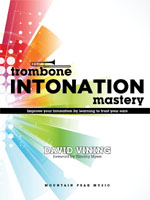Vining, David Intonation Mastery
Trombone Studies & Etudes

-
Vining, David
Intonation Mastery
Trombone Intonation Mastery by David Vining is appropriate for high school through professional trombone players.How do you know if you're playing in tune? Is it by looking at a tuner, by comparison to other members of your ensemble, or something else entirely? Trombone Intonation Mastery offers even seasoned musicians new ways to think about intonation, focusing on specific trombone techniques so you can genuinely learn how to listen carefully and adjust precisely. It will help you cultivate trust in this basic skill so you can confidently play in tune regardless of the playing situation you face. Trombone Intonation Mastery is an interactive tutorial that will help you improve your intonation through playing etudes, fundamentals, and duets.
Recalibrate your perception of intonation, and increase the accuracy of your intonation with Trombone Intonation Mastery!
"David Vining has filled a big gap in the pedagogical literature with Trombone Intonation Mastery. It thoroughly defines the issues and presents intuitive, well-thought-out remedies that lay out a path to positive results. Useful for advanced high schooland college students (and professional players, for that matter), this book's unique approach is to incorporate specific attention to intonation into a volume that includes exercises, routines, etudes, and duets. This book contains enough material to keep a trombonist busy for a long time. Trombone Intonation Mastery offers a concrete way forward." - Timothy Myers, Principal Trombone, St. Louis Symphony Orchestra
"I am very pleased to recommend Trombone Intonation Mastery by David Vining. I have been searching for new material to use in my own practice and teaching, and this volume approaches trombone-specific tuning issues in an organized, systematic way that will aid players of all ability levels. Through the use of various tools (tuner, drones, and duets), trombonists have the means to discover their own tendencies and correct bad habits. The position specific etudes and routines are the perfect material tohelp you settle into correct fundamental slide placement, and the exercises that cover the harmonic series and intervals over drones will have you listening and adjusting like true intonation masters. The duets, particularly those that directly referencefamiliar solos and orchestral excerpts, provide the necessary real-life application of these critical skills. I look forward to incorporating Trombone Intonation Mastery into my studio!" - Dr. Dan Cherry, Assistant Professor of Trombone, West Chester University of Pennsylvania, Trombonist, Balaton Chamber Brass
"In this book, David Vining provides a new approach to developing a broader understanding of intonation for the trombonist. The exercises go beyond the perfunctory practice of isolating notes with the tuner or drone, and give the reader a better foundation for real life execution of proper intonation. It's like intonation on steroids!" - Michael Becker, Principal Trombone, Tucson Symphony Orchestra
132 pages, spiral bound to lay flat on the music stand.
-
- Category: Trombone Studies & Etudes
- Item: 116246
- Grade/Level:
- Price: $29.95
-
(usually ships in 24 hours)
